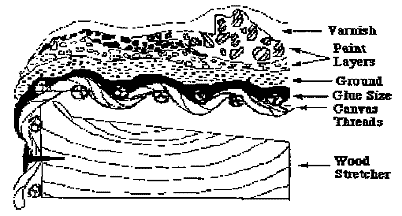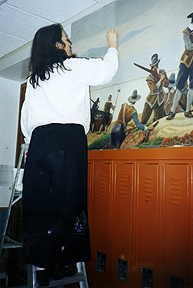
ART
RESTORATION Originally published in Cape Cod Art & Antiques, July 2002, cover story In the midst of fears and challenges of war, of bombs, famine and death, can anyone really bother about a minuscule film of paint? All I can say is that this experience magnified for me the issue of the stewardship of our heritage, of the relationship between art and cultural history. It made me wonder how we are keeping other significant treasures from the amazing century of art created in this place; and even on a personal level, how am I taking care of my own small collection, and my own family's visual heritage. My grandmother, born in 1886, was a painter. I suppose she would fall into that category of Sunday painters, as it was something she did for her pleasure among all the other activities of home and children and community service. I wish I knew more about her painting life, but I do have one of her paintings. It's in storage now because in one of my many moves, it was badly torn. My brother has one, too, a very beautiful harbor. That lovely picture has hung in his foyer for a long time and every time I visit him, it's the first thing I see when I enter the front door. The last time I visited, he had moved it to another place, hanging opposite the wall of full-length windows that lead to his backyard in countryside Pennsylvania. It was lit by the clear afternoon sun, and I was shocked to see the color and depth of perspective distorted by the dulled varnish and surface grime collected over the years. Both paintings could be beautifully restored by a trip to Kristina Bird’s studio. Kristina Bird, a professional painting restorer who lives and works in Truro, tells me that the choice between the two words "restoration" or "conservation" is a semantic one, with conservation historically connoting a kind of inflated status that some sectors of the profession claim. I cannot begin to understand the complexities of the modern restoration industry, its various branches, subdivisions, and operatives, so I went to Kristina for basic instruction. Bird practices her profession in a small studio behind her home on Old Country Road in Truro. She bought the small cottage for $500.00 about ten years ago and has just enlarged it, adding heat, modern wiring, security, and a corner of windows open to north light where she does the painting touch-up requiring perfect color matching. The walls are hung and the floor stacked with paintings in various stages of restoration. Before the renovation of the cottage, Bird worked winters in her kitchen. She's thrilled to have a year round studio at last, and belying her extensive top-of-the-line education and experience, she makes the work of restoration accessible. For a long time, restoration was promoted as a kind of mysterious art, with 'secret formulas' claimed by various practitioners, but now it's really about well-researched, scientifically based, standard techniques, Bird says, and she readily shares her knowledge with colleagues and clients. Bird came to her profession by a fortuitous accident of place. She grew up in a home filled with wonderful art (her Boston grandmother was a serious and extensive collector), and she knew artists and their families from her seasons spent in Truro at her grandmother's summer home, so she came by an art history education naturally. After college, an international studies major, she went to work in New York with a large corporation in the accounting department. All of her friends in NY were artists. She began to think of a career in arts administration, perhaps museum work, and traveled to Italy to learn Italian. While going to and from class in Florence, she discovered the Istituto per L'Arte e il Restauro just down the street, observed the work, and knew it was what she wanted to do. She completed the two-year studies program of chemistry, art history, photography, drawing and restoration theory, and remained another year to projects in Rome, Spoletto, and Naples. She studied more chemistry at Harvard (in English!), then worked in Boston and London in both private and in institutional conservation laboratories to complete the seven-year apprenticeship required for a diploma. Since relocating to the lower Cape, Bird's clients include the Town of Provincetown, the Society for the Preservation of New England Antiquities, the Seaman's Church Institute of Newport, and many individuals. Bird's
first assignments were in restoring frescos in Italy, and she has
worked with bronze, paper, silver and textiles. She learned
gilding
and
added framework
to her repertoire. She spent a year in the Objects Restoration
Department at Harvard's Fogg Museum. Now she specializes in paintings.
And there
is no lack
of work here at the edge of the world. The lower Cape is unique
in its concentration of museums, collectors, art dealers, and artists
as it
was the summer center
of American painting for a long time, especially for painting.
Some
of those paintings have been subject to fluctuating temperatures,
humidity, dust,
pollution, pests, and mishandling for decades.
When Bird receives a painting, she first does a "Painting Condition Report". This diagnostic assessment covers everything from the frame, to the stretcher or strainer, the support (usually canvas or panel), the ground, the paint layer(s), the surface coating, and including the history of the painting, such as artist, period, provenance. She prepares a "Treatment Recommendation" and gives the client an estimate of the cost of restoration, based on hours required to complete the project. She makes photographic documentation of the entire restoration process and maintains the record. One piece may need only a thorough cleaning, while another may need complete attention from reconstructing the canvas to final varnish. Bird works with an assistant, using techniques and materials she has found most effective over the years. When she encounters new problems, she often consults with long-established colleagues such as Polly Blackett of London and Peter Williams of Boston. This sharing of work and ideas is one of the things she values most. The essential rule of restoration is that everything has to be reversible. The conservator must avoid adding anything to an object that cannot be easily removed or identified. This reversibility is the focus of a great deal of the controversy around the activity of restoration. Some art experts believe that current restoration materials and practices are not as benign as the practitioners would have us believe. Others question what ideas and standards inform the restorer's choices. There has been much high profile discussion in the last couple of years over the planned restoration of the Uffizi Gallery's Adoration of the Magi by Leonardo da Vinci. According to Artwatch International, an organization whose mission is to hold accountable those responsible for the custodianship of our collective inherited imagery, much of the world's art heritage has been systematically 'adjusted' to meet certain undefined standards but with all-too identifiable effects. In most countries, there are still no state examinations or certifying structures in place for this profession. Artwatch's Bill of Rights for a Work of Art makes for interesting reading and thoughtful consideration and can be found at www.artwatchinternational.org. Over
time, all organic objects change or deteriorate as a result of
environmental conditions, use, accidents, forces
of natural
decay, deliberate destruction
(I think of Alice Neel, whose lover Kenneth Doolittle
burned hundreds of her drawings
and watercolors and slashed more than 50 paintings),
war and political conflict. Paintings are fragile creations
that
tell
of our culture
and values and heritage,
tell us who we are, and they require special care to
assure their continued
presence and enjoyment. RESOURCES: Illustration
#1
Illustration #3: |
 The
importance of art restoration, conservation, and preservation came
into focus this year when I visited in the home of
a friend who has
inherited a substantial art collection, including some important
paintings from the early days of the Provincetown colony.
I was so happy to see
the paintings, but so saddened at their cracked, buckled, and soiled
condition.
The
importance of art restoration, conservation, and preservation came
into focus this year when I visited in the home of
a friend who has
inherited a substantial art collection, including some important
paintings from the early days of the Provincetown colony.
I was so happy to see
the paintings, but so saddened at their cracked, buckled, and soiled
condition. 
